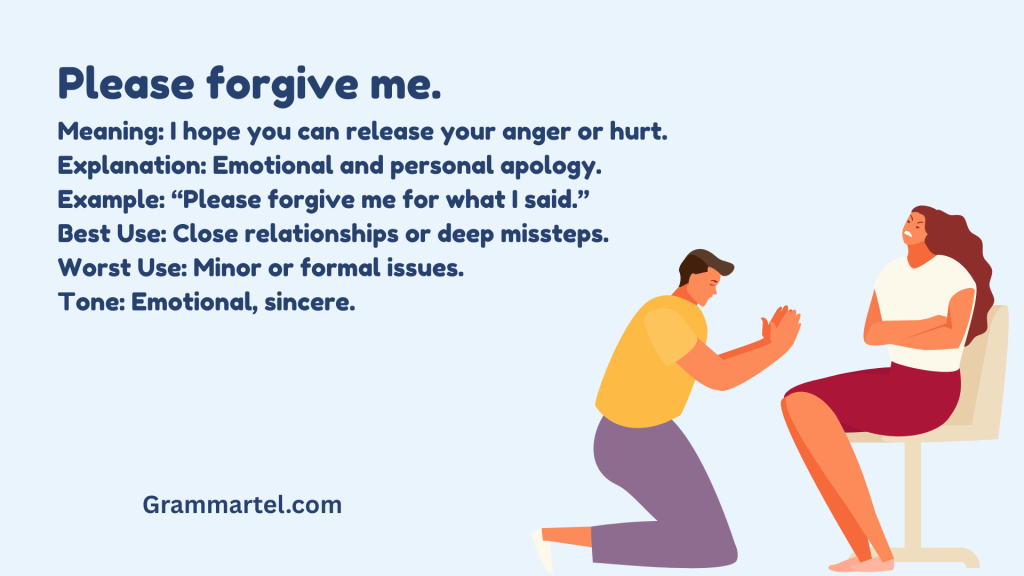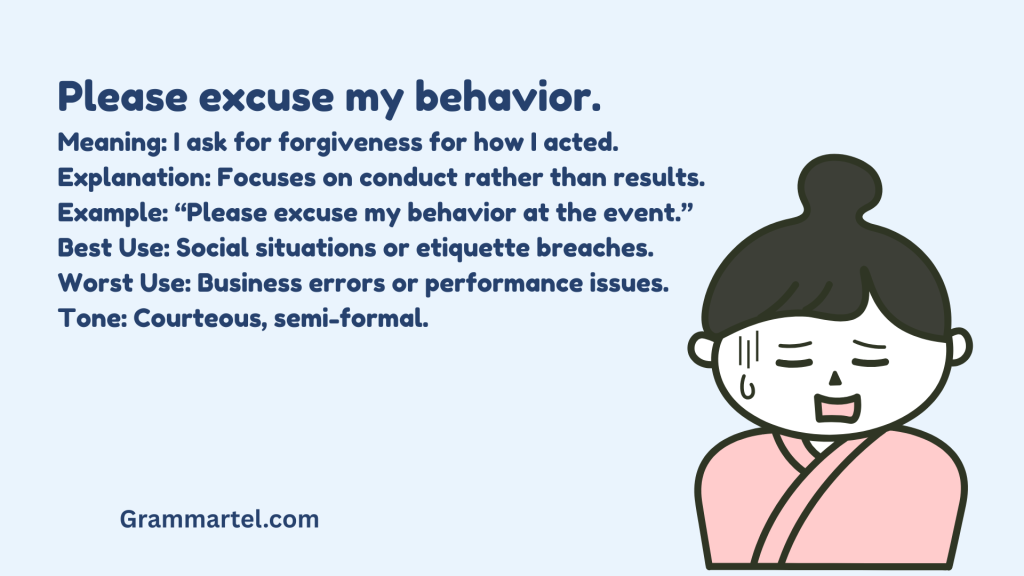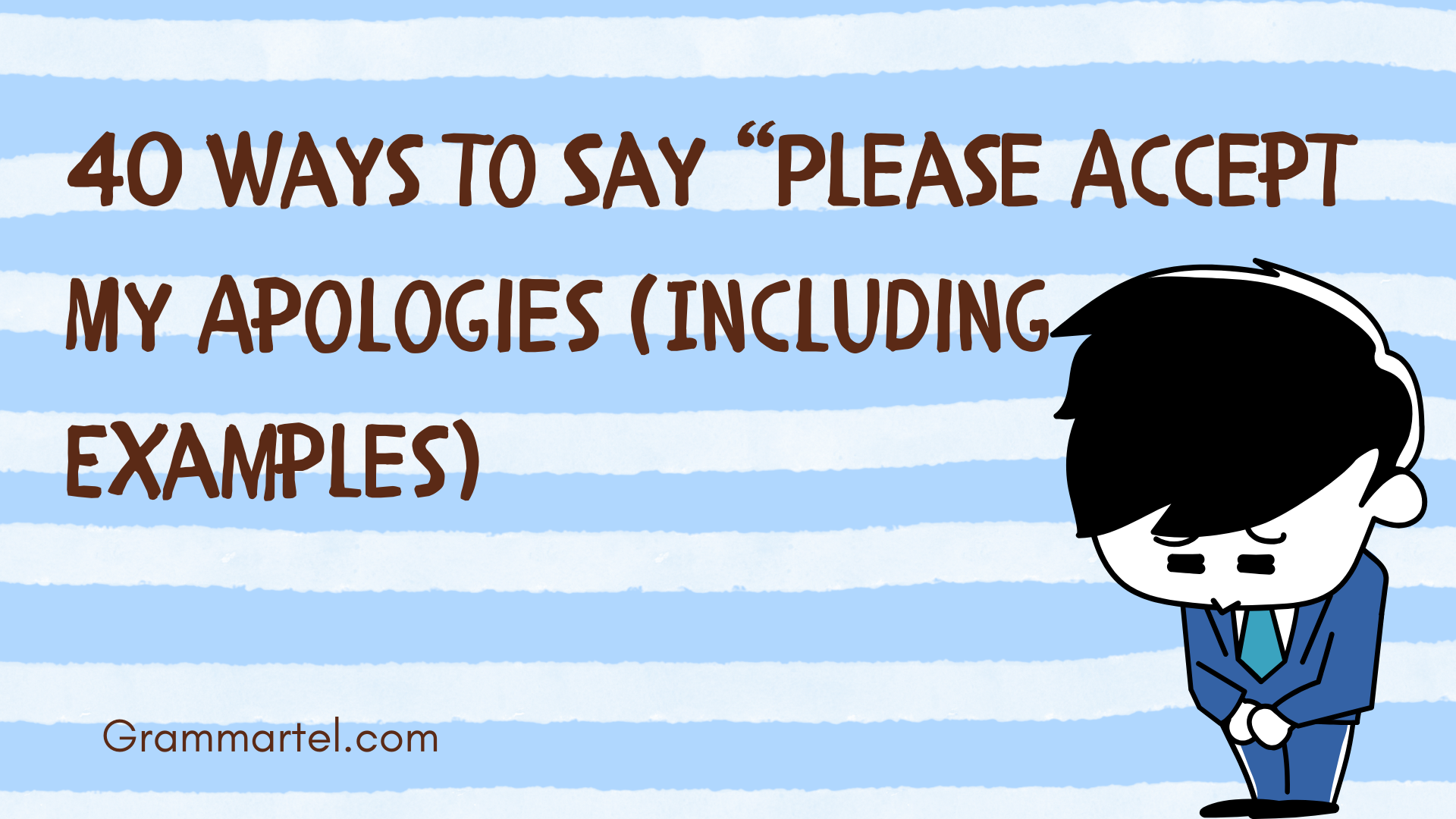Apologizing is an important part of mending relationships, but sometimes saying “sorry” isn’t enough. Finding creative ways to show you truly regret your actions can go a long way. Whether it’s through heartfelt gestures, thoughtful words, or small acts of kindness, a unique apology can demonstrate your sincerity. In this article, we’ll explore 40 creative ways to express your apologies, complete with examples to help you make amends in a meaningful way.
What Does “Please Accept My Apologies” Mean?
The phrase “Please accept my apologies” is a formal and polite way of expressing regret or sorrow for something you may have done wrong or for an inconvenience caused. It’s a respectful way of acknowledging a mistake, misunderstanding, or any action that may have negatively affected someone else. It shows that you are taking responsibility for the situation and want to make amends. By using this phrase, you communicate both your awareness of the issue and your desire to make things right.
When to Use “Please Accept My Apologies”
You should use “Please accept my apologies” in situations where you want to express regret and take responsibility for a mistake or inconvenience in a respectful and formal manner. This phrase is often used in both professional and personal contexts to maintain decorum and show sincerity.
Here are some common scenarios where it’s appropriate to use this phrase:
- Apologizing for a Mistake: If you’ve made an error or oversight, this phrase can help you take responsibility in a gracious and formal way.
- When Causing an Inconvenience: If your actions or decisions have caused inconvenience, using this phrase shows that you acknowledge the impact on others and are sorry for it.
- In Professional Communication: In formal emails or letters, especially in the workplace, it’s a more polished way of apologizing when addressing a client, colleague, or superior.
- When Addressing Sensitive Situations: If you need to apologize for something serious or potentially hurtful, this phrase helps maintain a respectful and sincere tone.
In essence, “Please accept my apologies” is a thoughtful and courteous way of offering an apology, particularly when you want to maintain professionalism and show that you genuinely regret any negative outcomes.
40 Ways to Say “Please Accept My Apologies (Including Examples)
1. I’m truly sorry.
Meaning: I deeply regret what happened.
Explanation: Expresses sincere remorse.
Example: “I’m truly sorry for missing the deadline.”
Best Use: Personal or professional situations.
Worst Use: Trivial or sarcastic contexts.
Tone: Sincere, heartfelt.
2. My sincere apologies.
Meaning: I genuinely regret my actions.
Explanation: Formal and polite way to express apology.
Example: “My sincere apologies for the confusion.”
Best Use: Business emails, professional missteps.
Worst Use: Overused in casual contexts.
Tone: Formal, respectful.
3. I apologize.
Meaning: I admit fault and express regret.
Explanation: Straightforward and formal.
Example: “I apologize for the mistake in the report.”
Best Use: Workplace, formal conversations.
Worst Use: May seem cold if the situation is personal.
Tone: Neutral, professional.
4. I’m sorry for the inconvenience.
Meaning: I regret causing trouble or difficulty.
Explanation: Often used in customer service or formal settings.
Example: “I’m sorry for the inconvenience caused by the delay.”
Best Use: Business settings or public service.
Worst Use: Emotional or personal conflicts.
Tone: Polite, distant.

5. Please forgive me.
Meaning: I hope you can release your anger or hurt.
Explanation: Emotional and personal apology.
Example: “Please forgive me for what I said.”
Best Use: Close relationships or deep missteps.
Worst Use: Minor or formal issues.
Tone: Emotional, sincere.
6. I deeply regret my actions.
Meaning: I’m ashamed of what I did.
Explanation: Communicates remorse with gravity.
Example: “I deeply regret my actions during the meeting.”
Best Use: Serious errors or public statements.
Worst Use: Small, casual missteps.
Tone: Grave, formal.
7. I take full responsibility.
Meaning: I own up to my mistake.
Explanation: Shows accountability.
Example: “I take full responsibility for the delay.”
Best Use: Leadership, serious work matters.
Worst Use: When you’re not actually at fault.
Tone: Responsible, mature.
8. I didn’t mean to hurt you.
Meaning: I regret causing pain.
Explanation: Explains intent and expresses care.
Example: “I didn’t mean to hurt you with my words.”
Best Use: Emotional or personal conflicts.
Worst Use: Professional missteps.
Tone: Tender, sincere.
Check This Out: 40 Different Ways to Say “I’d Be Happy To” (Examples Included)
9. That was my fault.
Meaning: I admit blame.
Explanation: Directly takes accountability.
Example: “That was my fault—I misunderstood.”
Best Use: Informal or team environments.
Worst Use: If it downplays serious errors.
Tone: Honest, direct.
10. I was wrong.
Meaning: I acknowledge my mistake.
Explanation: Simple and powerful admission.
Example: “I was wrong to jump to conclusions.”
Best Use: Personal or team settings.
Worst Use: Formal legal contexts.
Tone: Honest, humble.
11. I offer my sincerest apologies.
Meaning: I genuinely regret my actions.
Explanation: A very polite and respectful way to apologize.
Example: “I offer my sincerest apologies for missing the event.”
Best Use: Formal letters or official communication.
Worst Use: Casual texts or lighthearted errors.
Tone: Formal, respectful.
12. I’m ashamed of what happened.
Meaning: I feel deep remorse.
Explanation: Strong emotional expression of regret.
Example: “I’m ashamed of what happened and how it unfolded.”
Best Use: Deep personal or moral failures.
Worst Use: Light mistakes or minor issues.
Tone: Emotional, vulnerable.
13. Please accept my heartfelt apology.
Meaning: I deeply regret what I did.
Explanation: Emphasizes emotional sincerity.
Example: “Please accept my heartfelt apology for the offense.”
Best Use: When personal feelings were hurt.
Worst Use: Professional or transactional settings.
Tone: Warm, emotional.
14. I didn’t handle that well.
Meaning: I admit my mistake in how I acted.
Explanation: Soft admission of wrongdoing.
Example: “I didn’t handle that well, and I’m sorry.”
Best Use: Team or relationship settings.
Worst Use: Legal or formal apologies.
Tone: Honest, reflective.
15. I regret what I said.
Meaning: I take back my words.
Explanation: Targets verbal missteps.
Example: “I regret what I said during the meeting.”
Best Use: Conflict resolution, relationship repair.
Worst Use: Situations where actions—not words—caused harm.
Tone: Regretful, specific.
16. I made a mistake.
Meaning: I did something wrong.
Explanation: Simple and clear acknowledgment of error.
Example: “I made a mistake and I apologize.”
Best Use: Honest conversation in any setting.
Worst Use: When the mistake had severe consequences (sounds too light).
Tone: Direct, humble.

17. Please excuse my behavior.
Meaning: I ask for forgiveness for how I acted.
Explanation: Focuses on conduct rather than results.
Example: “Please excuse my behavior at the event.”
Best Use: Social situations or etiquette breaches.
Worst Use: Business errors or performance issues.
Tone: Courteous, semi-formal.
18. I never meant to upset you.
Meaning: I didn’t intend to cause emotional distress.
Explanation: Expresses care and clarifies intent.
Example: “I never meant to upset you with that comment.”
Best Use: Personal conflict or miscommunication.
Worst Use: Work environments where intent doesn’t matter.
Tone: Kind, gentle.
19. That shouldn’t have happened.
Meaning: I acknowledge it was wrong.
Explanation: Accepts that the outcome was inappropriate.
Example: “That shouldn’t have happened, and I’m sorry.”
Best Use: Addressing process failures or oversights.
Worst Use: When accountability is vague.
Tone: Reflective, responsible.
20. I see how that affected you.
Meaning: I understand the impact I caused.
Explanation: Validates the other person’s experience.
Example: “I see how that affected you, and I’m truly sorry.”
Best Use: Empathetic apologies.
Worst Use: If you’re not actually willing to listen.
Tone: Compassionate, understanding.
21. I completely understand your frustration.
Meaning: I empathize with your reaction.
Explanation: Shows emotional awareness while apologizing.
Example: “I completely understand your frustration, and I’m sorry.”
Best Use: Customer service, conflict resolution.
Worst Use: If used without taking responsibility.
Tone: Empathetic, respectful.
22. I acknowledge my mistake.
Meaning: I recognize and accept fault.
Explanation: A professional way to take accountability.
Example: “I acknowledge my mistake in the scheduling mix-up.”
Best Use: Workplace communication.
Worst Use: Personal relationships (too cold).
Tone: Formal, composed.
Try This: 40 Better Ways to Say “Quick Learner” (With Examples)
23. Please allow me to make it right.
Meaning: Let me fix my mistake.
Explanation: Offers both apology and solution.
Example: “I’m sorry. Please allow me to make it right.”
Best Use: Customer recovery or personal trust rebuilding.
Worst Use: When no action can undo the harm.
Tone: Responsible, proactive.
24. It won’t happen again.
Meaning: I promise to change my behavior.
Explanation: Acknowledges fault and vows improvement.
Example: “I apologize. It won’t happen again.”
Best Use: Workplace or school-related mistakes.
Worst Use: Repeated offenses.
Tone: Assuring, corrective.
25. That was inappropriate, and I apologize.
Meaning: I accept that my actions were out of line.
Explanation: Strong acknowledgment of wrongdoing.
Example: “That was inappropriate, and I apologize for my behavior.”
Best Use: Formal or disciplinary apologies.
Worst Use: Informal jokes or lighthearted mistakes.
Tone: Serious, formal.
26. I’m sorry for letting you down.
Meaning: I didn’t meet your expectations.
Explanation: Admits failure and expresses care.
Example: “I’m sorry for letting you down on this project.”
Best Use: Mentorships, friendships, team settings.
Worst Use: Objective mistakes with no personal connection.
Tone: Sincere, heartfelt.
27. I’m sorry for my part in this.
Meaning: I accept responsibility for my contribution to the issue.
Explanation: Fair-minded and balanced apology.
Example: “I’m sorry for my part in this misunderstanding.”
Best Use: Conflict resolution, shared disputes.
Worst Use: When full accountability is expected.
Tone: Fair, diplomatic.

28. Thank you for your patience—and I’m sorry.
Meaning: I appreciate your understanding, and I regret the issue.
Explanation: Combines gratitude with apology.
Example: “Thank you for your patience—and I’m sorry for the delay.”
Best Use: Customer support, logistics issues.
Worst Use: If you’re not correcting the issue.
Tone: Appreciative, respectful.
29. That was unprofessional of me.
Meaning: I acted inappropriately for the setting.
Explanation: A formal acknowledgment of behavior.
Example: “That was unprofessional of me. I apologize.”
Best Use: Office conduct or etiquette slips.
Worst Use: Non-work settings.
Tone: Professional, humble.
30. Please let me make amends.
Meaning: I want to repair the damage.
Explanation: Expresses a desire to restore trust or fix the harm.
Example: “Please let me make amends for how I treated you.”
Best Use: Personal relationships, ethics issues.
Worst Use: When nothing can be done to repair it.
Tone: Earnest, restorative.
31. I accept full accountability.
Meaning: I own up to my role without excuse.
Explanation: A strong leadership-level apology.
Example: “I accept full accountability for the missed deadline.”
Best Use: Managerial roles, formal business statements.
Worst Use: Overly casual or personal issues.
Tone: Formal, strong.
32. I should have handled it differently.
Meaning: I recognize my mistake in approach.
Explanation: Softens the admission with reflection.
Example: “I should have handled it differently, and I apologize.”
Best Use: Coaching, conflict repair.
Worst Use: When a direct apology is needed.
Tone: Reflective, sincere
33. I see where I went wrong.
Meaning: I’ve realized my mistake.
Explanation: Acknowledges learning from the situation.
Example: “I see where I went wrong, and I apologize.”
Best Use: Collaborative or coaching environments.
Worst Use: Highly formal settings.
Tone: Humble, introspective.
34. That wasn’t fair to you.
Meaning: I acknowledge I acted unfairly.
Explanation: Empathizes with the harmed party.
Example: “That wasn’t fair to you, and I’m sorry.”
Best Use: Personal or peer relationships.
Worst Use: Business or contractual issues.
Tone: Compassionate, apologetic.
35. I failed to live up to expectations.
Meaning: I did not meet the expected standard.
Explanation: Professional way to admit underperformance.
Example: “I failed to live up to expectations. I apologize.”
Best Use: Reviews, business apologies.
Worst Use: Emotional or personal conflict.
Tone: Formal, constructive.
36. I misunderstood the situation.
Meaning: My error came from a lack of clarity.
Explanation: Clarifies the source of mistake and apologizes.
Example: “I misunderstood the situation—my apologies.”
Best Use: Miscommunication issues.
Worst Use: When the mistake wasn’t about misunderstanding.
Tone: Honest, explanatory.

37. I’m working to do better.
Meaning: I’m actively trying to improve.
Explanation: Suggests growth beyond the apology.
Example: “I’m sorry—and I’m working to do better.”
Best Use: Coaching, team leadership, relationships.
Worst Use: If you don’t intend to change.
Tone: Hopeful, forward-looking.
38. I shouldn’t have said that.
Meaning: I regret my words.
Explanation: A specific apology for something spoken.
Example: “I shouldn’t have said that. I’m sorry.”
Best Use: Heated conversations, emotional outbursts.
Worst Use: Non-verbal issues.
Tone: Direct, remorseful.
39. I owe you an apology.
Meaning: You deserve to hear me say sorry.
Explanation: Acknowledges responsibility and builds up to apology.
Example: “I owe you an apology for how I handled things.”
Best Use: Personal or professional accountability.
Worst Use: When used but not followed by actual remorse.
Tone: Humble, respectful.
40. Please accept my apology for any harm caused.
Meaning: I acknowledge my actions and their potential impact.
Explanation: Careful and considerate formal apology.
Example: “Please accept my apology for any harm caused by my comments.”
Best Use: Formal documents, public relations.
Worst Use: Very personal or informal situations.
Tone: Formal, neutral.
Conclusion
Apologizing creatively can strengthen your bond with someone and show that you care deeply. The key is to be genuine and thoughtful in your approach. Whether through a written note or a small act of kindness, the effort you put into your apology speaks volumes. Always remember, a sincere apology can heal wounds and bring people closer together. Bring your writing to life and captivate with Grammartel.

